Hinge Terminology
Types of Hinges and Hinge Terminology
At Larsen and Shaw, we know a thing or two about hinges. Although you might not have considered the breadth and complexity of hinges in the past, when you start to look at the combinations of material, shape, size and functionality, the types of hinges that exist will become mind boggling.
There are standard hinges, those that are typically recognizable by their shape. But standard hinges can quickly become custom hinges when you start to make changes in their pitch, add swaging or reverse assembly.
Although we supply standard hinges in a wide variety of options, we specialize in manufacturing custom hinges with all types of dimensions, knuckle sizes, offsets and so much more. What can start out seeming like a simple standard hinge might be more then you expected, but that’s why we’re here. At Larsen and Shaw, we’re the Hinge People® and if you can dream it, we can make it.
Below are some examples of various hinge customizations. Feel free to browse around, or if you want to discuss your hinge project, contact us.

Plain or Standard Assembly
Leaves lay flat in the same plane in an open position.
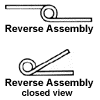
Reverse Assembly
Opposing leaves extend laterally from opposite sides of the pin.
Leaves will not close to a parallel position.
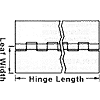
Length
The length of the hinge measured parallel to the pin.
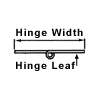
Width
The overall dimension of the leaves measured perpendicular to, or across the pin.

Leaf
The portion of the hinge extending laterally from the knuckle, which is curled around a pin.

Leaf Width
The dimension from the center of the pin to the outer edge of the leaf.
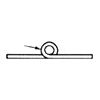
Knuckle
The hollow circular part at the joint of a hinge through which a pin is passed (other terms for this are loop, joint, node, curl, and barrel).
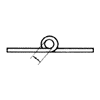
Inside Knuckle Diameter
(also called Pin Diameter)
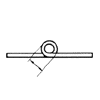
Outside Knuckle Diameter
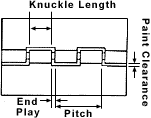
Knuckle Length
The nominal dimension of the knuckle measured parallel to the pin.

Paint Clearance
The minimum dimension between the outer face of the knuckle and the opposing edge of the cut out, over the entire range of pivotal movement of the hinge.

End Play
The amount of axial movement between the leaves.

Side Play
The amount of movement of the leaves perpendicular to the pin (occurs when inside knuckle diameter is larger than the pin).

Pitch
The dimension from a point on the knuckle to the same point on the next knuckle on the same leaf.

Swaging
Forming one or both leaves, within the proximity of the paint clearance, toward or beyond the center of the pin (swaging slightly increases the width of a hinge).

One Leaf Half Swaged
One leaf half swaged one half the pin diameter.

One Leaf Full Swaged
One leaf swaged equal to the pin diameter and both leaves parallel when in closed position.

Both Leaves Half Swaged
Both leaves swaged approx. one half the pin diameter with a minimum clearance between the leaves when parallel.

Reverse Swaged
One leaf swaged to simulate reverse assembly.
Leaves will not close to a parallel position.

Center Swaged
Both leaves swaged by one half the pin diameter plus one half the material thickness so that both leaves are symmetrical on the center line.
Leaves will not close to a parallel position.

Offset
One or both leaves formed in the proximity of the paint clearance, away from the center of the pin.
When both leaves are offset and in a closed and parallel position, the dimension between the leaves will be greater than the pin diameter (reduces the width).

Stop Hinge
A hinge manufactured to limit the travel of the leaves to a specified angle.

Stop Hinge, Outside
Leaves will move from an open or flat position and stop at a specified angle.

Stop Hinge, Inside
Leaves will open from a closed position (leaves parallel to each other) and stop at a specified angle.

QAL Stop Hinge
A stop hinge with the quick-a-line feature.
In addition to the above characteristics of a hinge that you will want to consider, there are various types of hinges that we specialize in manufacturing to your specifications. Here are just a few of the more common examples:
Quick-A-Line Hinges
A continuous hinge manufactured with a weld guide feature for ease of installation and perfect alignment every time.
Quick-A-Line Hinges come in a variety of sizes including:
- 0.030" thick steel with 0.090" steel pin (1/4" knuckles)
- 0.060" thick steel with 0.125" steel pin (1" knuckles)
The standard length for a Quick-A-Line hinge is 72", however we can be make these to meet your customer specifications.
Advantages of Quick-A-Line Hinges:
- Means of rapidly aligning the hinge to the stock for welding purposes which reduces labour costs for installation of the hinge
- Means of preventing paint or finish loss from the barrel (joint), which is the most observable part of the hinge when mounted which improves the aesthetic appearance of the hinge.
Pin Assembly for Continuous Hinges
Another consideration in the manufacturer of your hinge is the various types of pin retention which include.
- Staking
- Press tightening
- Welding the pin to end knuckles
- Crimping end knuckles
- Forming or folding pin ends (to facilitate removal)
Each of these different forms of pin retention have their own unique benefits that can enhance your product and ensure your hinge investment aligns with your budget.
For more information or to get a quote for your project, contact us.
 Skip to main content
Skip to main content
